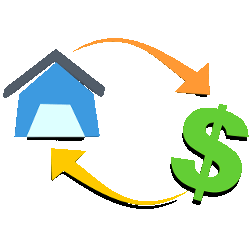If you are looking for a flexible option for staying in a house when you have lost control of mortgage payments, received a demand notice from your lender, facing potential foreclosure, or you are within your redemption period after a Statement of Claim has been issued, then a Rent-to-Own Refinance could make a lot of sense. This is when you sell your home, lease it from an investor with the intention of buying the home back. How does renting to own work? It functions much like the way it sounds. An investor leases a property to a homeowner turned tenant-buyer. At the end of that time period, the tenant-buyer can buy the house, walk away from it, extend the agreement, or just continue renting.
Some homeowners need to take advantage of this process because they have fallen behind on house payments and a mortgage option is not available. They find an investor to buy the house and lease it back to them. A portion of the proceeds of the sale to the investor is set aside towards the future down payment when you are ready to purchase the home back. The amount set aside for the future down payment depends on the specifics of the request, but generally like to see at least 5% – 10% or more. The investor may credit some of the rent as part of the purchase price as well. If the tenant has found some financing to start a new loan at the end of the agreement, the tenant-buyer purchases the house back.
If you want to know how Rent-to-Own Refinance works in Canada, here is a basic overview of the steps involved.
Your application is evaluated to determine the likelihood of being able to purchase the home back at the end of the lease term is possible. Credit is of very little concern. The primary focus is the property investment, and the likelihood of the tenant-buyer being able to buy the home back.
In a typical Rent-to-Own Refinance, The rent starts, and the Investor Landlord takes both a deposit and a security deposits from the proceeds of the sale. Parties sign a purchase buy-back agreement as well as a traditional lease. A portion of the rent counts toward the eventual purchase price. This percentage is at the landlord’s discretion but is a part of the agreement that you negotiate.
Why could this make sense?
- You avoid foreclosure which would remain on your credit for 6 years
- You avoid having to look for a new home, and finding a new neighborhood that is suitable for your family. If you have kids, this can be a daunting. If you have pets, your rental options are limited.
- You get to build credit and improve your situation during the term with a contract in place ready for you to complete and buy the home back.
- No need to start from scratch and look again for your dream home. You are likely already living in it.
Why is could this be a bad deal?
- You have no guaranteed loan at the end of the term. You need to work to improve your situation and save the necessary down payment to buy back.
- The rent is a bit higher than market rents.
Amansad Financial works with trusted referral partners to assist when a mortgage is not possible:
Below is a summary of our preferred urban markets by location:
BC (Exceptions may apply)
- Vancouver & the Greater Area
- Victoria
- Nanaimo
- Abbottsford
- Victoria
- Kelowna
- and other municipalities in southern BC with populations north of 30,000
Alberta (Exceptions may apply)
- Edmonton & direct surrounding area
- Calgary & direct surrounding area
- Leduc
- Red Deer
- Lethbridge
- Lloydminster
- and other municipalities in southern BC with populations north of 30,000
Saskatchewan (Exceptions may apply)
- Saskatoon
- Regina
- Yorkton
- and other municipalities in southern BC with populations north of 30,000
Ontario (Exceptions may apply)
- Toronto and the entire GTA
- Hamilton
- Ottawa
- and other municipalities in southern BC with populations north of 30,000

